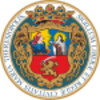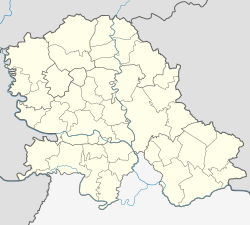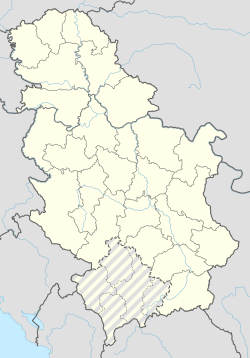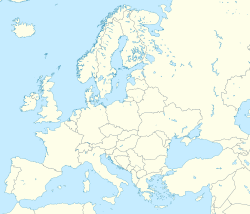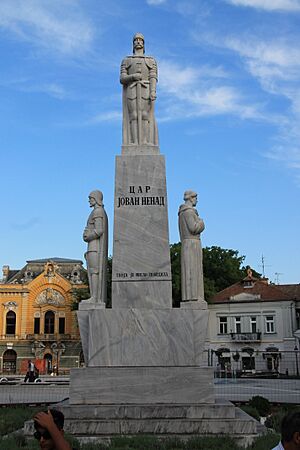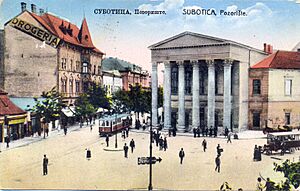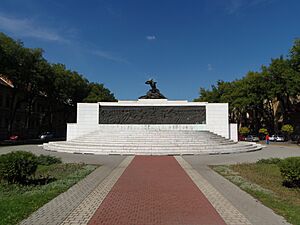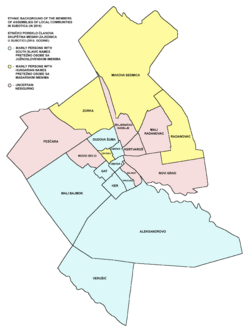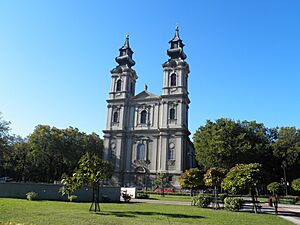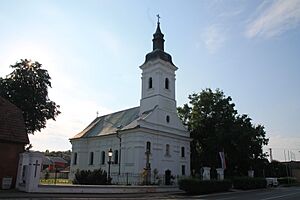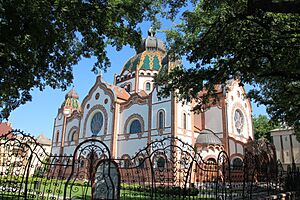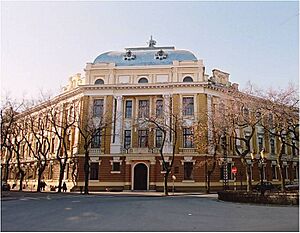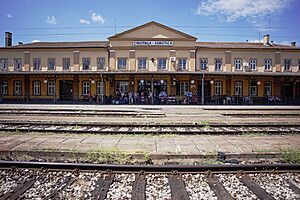Subotica facts for kids
Quick facts for kids
Subotica
|
|||
|---|---|---|---|
| Град Суботица Grad Subotica City of Subotica |
|||
|
Panorama of Subotica
Subotica City Hall
Reichel Palace
Franciscan Church
St. Theresa of Avila Cathedral
St. George's Church
Former Savings Bank
Liberty Square
National Theater
Subotica Synagogue
|
|||
|
|||
| Country | |||
| Province | |||
| District | North Bačka | ||
| Settlements | 19 | ||
| Area | |||
| Area rank | 13th in Serbia | ||
| • Urban | 164.33 km2 (63.45 sq mi) | ||
| • Administrative | 1,007.47 km2 (388.99 sq mi) | ||
| Elevation | 109 m (358 ft) | ||
| Population
(2022 census)
|
|||
| • City | 94,228 | ||
| • Rank | 5th in Serbia | ||
| • Administrative | 123,952 | ||
| • Administrative density | 123.0329/km2 (318.6539/sq mi) | ||
| Time zone | UTC+1 (CET) | ||
| • Summer (DST) | UTC+2 (CEST) | ||
| Postal code |
24000
|
||
| Area code(s) | (+381) 24 | ||
| Vehicle registration | SU | ||
| Website | Official website: http://www.subotica.rs | ||
Subotica (pronounced soo-BOH-tee-tsa) is a city in Serbia. It is the main city of the North Bačka District in the region of Vojvodina. Subotica is the second largest city in Vojvodina, after Novi Sad. In 2022, the city had about 94,228 people living in it. The wider area, including nearby towns, had about 123,952 people.
Contents
About the City's Name
The name of Subotica has changed many times over history! The first known name was Zabotka or Zabatka in 1391. This is where the current Hungarian name, Szabadka, comes from.
Some people think Szabadka comes from a Slavic word meaning "a place with a market fair on Saturday." Others believe it comes from a Slavic word for "free," referring to settlers who were given freedom by the Habsburg rulers.
In the 1740s, the town was named after Maria Theresa of Austria, who was a powerful ruler. It was called Sent-Maria in 1743. Later, in 1779, it was renamed Maria-Theresiapolis.
Geography of Subotica
Subotica is located in a flat area called the Pannonian Basin. It is about 10 kilometers (6 miles) from the border with Hungary. This makes it the northernmost city in Serbia.
A beautiful place called Lake Palić is very close to the city. North of Subotica, near the Hungarian border, you can find sand dunes in an area called Subotička Peščara.
Climate
Subotica has a climate with warm summers. It gets all four seasons: warm summers, cool autumns, cold winters, and mild springs.
History of Subotica
![]() Kingdom of Hungary (c. 1301–1526)
Kingdom of Hungary (c. 1301–1526)
![]() Ottoman Empire (1542–1686)
Ottoman Empire (1542–1686)
![]() Habsburg monarchy (1686–1804)
Habsburg monarchy (1686–1804)
![]() Austrian Empire (1804–1867)
Austrian Empire (1804–1867)
![]() Austro-Hungarian Empire (1867–1918)
Austro-Hungarian Empire (1867–1918)
![]() Kingdom of Serbia (1918)
Kingdom of Serbia (1918)
![]() Kingdom of Yugoslavia (1918–1941)
Kingdom of Yugoslavia (1918–1941)
![]() Hungarian occupation (1941–1944)
Hungarian occupation (1941–1944)
![]() SFR Yugoslavia (1944–1992)
SFR Yugoslavia (1944–1992)
![]() Federal Republic of Yugoslavia (1992−2003)
Federal Republic of Yugoslavia (1992−2003)
![]() Serbia and Montenegro (2003–2006)
Serbia and Montenegro (2003–2006)
![]() Republic of Serbia (2006–present)
Republic of Serbia (2006–present)
Ancient Times
Long, long ago, in the Stone Age and Copper Age, many important cultures lived in the area where Subotica is now. Early people from Europe settled here around 3200 BC. Later, different groups like the Illyrians, Celts, and Dacians lived here. From the 1st century BC, the Sarmatians took control. After the 4th century AD, many different peoples and states ruled this land.
Early Middle Ages and Slavic People
In the early Middle Ages, various groups like the Huns, Avars, and Bulgarians ruled the Subotica area. Slavic people settled here in the 6th and 7th centuries. In the 9th century, the first Slavic states appeared in this region, including the Principality of Lower Pannonia and the Bulgarian Empire.
Late Middle Ages
Subotica likely grew when people moved there from villages destroyed during the Tatar invasions in 1241–42. When Zabadka was first written about in 1391, it was a small town in the Kingdom of Hungary.
Later, the city belonged to the powerful Hunyadi family. King Matthias Corvinus of Hungary gave the town to his relative, János Pongrác Dengelegi, who built a fortress in 1470 to protect it from the Ottoman Empire.
After a big battle in 1526, Subotica became part of the Ottoman Empire. Many Hungarian people left. A Serbian leader named Jovan Nenad took control of the area in 1526–27 and made Subotica his main city. He even called himself a Serbian "tsar" (emperor). But he was later killed, and his rule ended.
Ottoman Empire Rule
The Ottoman Empire ruled Subotica from 1542 to 1686. During this time, many people had left, so the Ottomans encouraged new settlers from the Balkans to come. These new settlers were mostly Orthodox Serbs. They farmed the rich land around Subotica.
Habsburg Monarchy
In 1687, about 5,000 people called Bunjevci settled in the area, including Subotica. After a major battle against the Ottomans in 1697, Subotica became part of a military border zone controlled by the Habsburg monarchy.
At first, Serbian military families had special rights for serving the Habsburgs. But Subotica slowly changed from a military town to a market town with its own rules in 1743. Many Serbs were unhappy about losing their special rights and left the town. Some started a new settlement nearby, and others even moved to Russia and named a new place there "Subotica."
In 1779, Empress Maria Theresa of Austria made Subotica a "Free Royal Town." This important status helped the city grow a lot. In the 1800s, the population doubled twice! Many people from all over the Habsburg monarchy moved to Subotica. This changed who lived in the city. At first, the Bunjevci were the largest group, but more and more Hungarians and Jews settled there.
Revolution of 1848-1849
During the 1848-49 Revolution, Subotica was meant to be part of an independent Serbian region, but Serbian troops couldn't take control. There was a battle between Serbian and Hungarian armies in 1849, which the Hungarians won.
After the Hungarian revolution was defeated, Subotica became part of a separate Habsburg province called Voivodeship of Serbia and Banat of Temeschwar. In 1853, Subotica got its impressive theater.
Austria-Hungary
After the Dual-Monarchy was formed in 1867 (creating Austria-Hungary), Subotica entered a "golden age" of development. Many schools opened, and in 1869, the railway connected the city to the rest of the world. An electrical power plant was built in 1896, helping the city grow even more.
Subotica became known for its beautiful buildings in the Hungarian Secession style, which is a type of Art Nouveau. A Jewish synagogue was built in this style in 1902.
Yugoslavia and Serbia
Subotica was part of Austria-Hungary until the end of World War I. In 1918, it became part of the Kingdom of Serbs, Croats and Slovenes (later called Yugoslavia). Subotica became a border town, and its fast growth slowed down for a while. Still, it was the third-largest city in Yugoslavia at that time.
In 1941, during World War II, parts of Yugoslavia, including Subotica, were taken over by Hungary. Many people suffered during this time. Sadly, about 7,000 people from Subotica were lost, including Serbs, Hungarians, and Jews. Before the war, about 6,000 Jewish people lived in Subotica, but many were taken away during the Holocaust. In 1944, the Axis forces left, and Subotica became part of the new Yugoslavia.
After the war, Subotica slowly became more modern. In the 1990s, during the Yugoslav wars, many Serb refugees came to the city from other areas. At the same time, some Hungarians and Croats, and even some local Serbs, left the region.
Cityscape and Architecture
Subotica is famous for its amazing buildings in the Hungarian Secession style. This style is a special kind of Art Nouveau that mixes nature-inspired designs with traditional Hungarian patterns.
Some of the most beautiful buildings include the City Hall (built 1908–1910) and the Subotica Synagogue (1902). These were designed by the same architects, Marcell Komor and Dezső Jakab. Another great example is the Raichle Palace, built in 1904 by Ferenc J. Raichle.
The city also has many churches, like the Cathedral of St. Theresa of Avila from 1797, and Eastern Orthodox churches from the 18th century. The Subotica Synagogue was beautifully renovated and reopened in 2018.
The historic National Theatre in Subotica, built in 1854, was partly taken down in 2007 for renovation. It is being rebuilt to bring back its original beauty.
| Hungarian Secession buildings | ||||
|---|---|---|---|---|
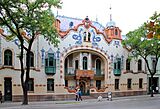 |
 |
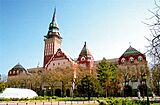 |
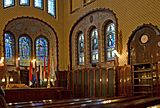 |
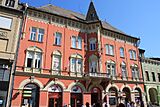 |
| Raichle Palace | Municipal Library | City Hall | Interior of the City Hall | Vojnića palace |
Neighborhoods and Villages
Subotica has many neighborhoods, each with its own character. Some of them are:
- Aleksandrovo
- Centar (City Center)
- Dudova Šuma
- Prozivka
- Novi Grad (New Town)
The larger area of Subotica also includes the town of Palić and 17 villages, such as:
- Bajmok
- Čantavir
- Kelebija
- Stari Žednik
People of Subotica
| Historical population | ||
|---|---|---|
| Year | Pop. | ±% p.a. |
| 1948 | 123,668 | — |
| 1953 | 126,559 | +0.46% |
| 1961 | 136,782 | +0.98% |
| 1971 | 146,770 | +0.71% |
| 1981 | 154,611 | +0.52% |
| 1991 | 150,534 | −0.27% |
| 2002 | 148,401 | −0.13% |
| 2011 | 141,554 | −0.52% |
| 2022 | 123,952 | −1.20% |
In 2022, the city of Subotica had 94,228 people. The wider administrative area had 123,952 people.
Ethnic Groups
Subotica is a very diverse city, meaning many different ethnic groups live there. According to the 2022 census, the main groups in the city are:
- Serbs: 34.34%
- Hungarians: 26.19%
- Croats: 7.40%
- Bunjevci: 6.52%
- Roma: 3.06%
In the wider Subotica area, the main groups are:
- Serbs: 30.8%
- Hungarians: 30%
- Croats: 8.42%
- Bunjevci: 7.31%
Some villages around Subotica have a majority of Serbs, others Hungarians, Croats, or Bunjevci.
Languages Spoken
In the Subotica area, Serbian is the most common language used every day. However, Hungarian is also spoken by almost 30% of the people. Both languages are used on signs and in official places. Other languages spoken include Croatian, Bunjevac, and Romani.
Religions
Subotica has many different religions. Almost half of the city's people are Catholic. It is the main city for the Catholic diocese in the Bačka region. There are many Catholic churches and religious communities here. Subotica also has the only Catholic high school in Serbia, called Paulinum.
The second largest Christian group is the Orthodox. There are two Orthodox churches in the city. Subotica also has two Protestant churches (Lutheran and Calvinist).
The Jewish community in Subotica is the third largest in Serbia. Sadly, many Jewish people were lost during World War II. Today, a smaller community remains.
Economy
The land around Subotica is mostly used for farming. But the city itself is an important center for industry and transportation in Serbia. Because of the farms, Subotica has famous food companies like "Pionir" (sweets), "Fidelinka" (cereals), and "Mlekara Subotica" (milk).
Some older industries are still active, like the "Azotara" chemical fertilizer factory and "Bratstvo" rail wagon factory. A big modern company is "Siemens Subotica," which makes parts for wind generators. Other important companies include Fornetti, ATB Sever, and Masterplast. Recently, Dunkermotoren and NORMA Group have also come to Subotica.
Tourism is also important, especially around Lake Palić, which hosts the Palić Film Festival. Subotica is known as a "festival city" because it hosts more than 17 festivals each year!
Subotica also has a free economic zone, which helps new businesses grow. In 2020, a new aqua park with ten pools and a spa was being built in Palić.
Here's a look at the types of jobs people have in Subotica (as of 2022):
| Activity | Total Workers |
|---|---|
| Agriculture, forestry and fishing | 445 |
| |align="right"|14,684 | |
| |align="right"|2,252 | |
| |align="right"|7,322 | |
| Transportation and storage | 3,568 |
| Accommodation and food services | 2,022 |
| Information and communication | 1,460 |
| |align="right"|2,637 | |
| Human health and social work | 3,382 |
| Public administration and defense | 1,876 |
| Total | 46,799 |
Education
Universities
Subotica is home to the Teacher Training Faculty in the Hungarian Language, which is part of the University of Novi Sad. This school trains teachers for kindergartens and elementary schools. Teaching has a long history in Subotica, going back to the late 1700s.
Secondary Schools
Subotica has several high schools, including:
- Polytechnic school (for technical skills)
- "Svetozar Marković" grammar school
- "Dezső Kosztolányi" Philological grammar school (for languages)
- "Tehnička Škola - Subotica" (Technical School)
- "Bosa Milićević" School of Economics
- "Medicinska Škola" (Medical School)
In 2020/21, about 4,953 students attended high school in Subotica. Many students choose to study in Hungarian (32.8%) or Croatian, while most study in Serbian.
Sports
Subotica has a main football stadium called the Subotica City Stadium. It also has an indoor sports arena and an indoor swimming pool. The local football team, Spartak, plays in Serbia's top football league.
Media
Here are some newspapers and magazines published in Subotica:
- Magyar Szó: a daily newspaper in Hungarian.
- Subotičke novine: the main weekly newspaper in Serbian.
- Hrvatska riječ: in Croatian.
- Bunjevačke novine: in Bunjevac.
Getting Around Subotica
A1 motorway connects Subotica to other major cities in Serbia like Novi Sad and Belgrade. It also connects to Szeged in Hungary. The city is also on the Budapest–Belgrade railway line, which is currently being rebuilt.
Subotica used to have a tram system, which started in 1897 and ran on electricity. This was quite advanced for its time! However, the tram system was stopped in 1974.
Today, Subotica has a bus system that helps people get around the city, to nearby suburbs, and even to Szeged in Hungary. The buses travel millions of kilometers each year and carry about ten million people.
The city also has a small airport, Subotica Airport, mainly used for recreational flying. Southwest of the city, there's a very tall mast (218.5 meters or 717 feet) for broadcasting radio and TV signals. It's one of the tallest in the region!
Famous People from Subotica
Many talented people were born or lived in Subotica, including:
- Branimir Aleksić (born 1990), a football player.
- Danilo Kiš (1935–1989), a famous writer.
- Dezső Kosztolányi (1885–1936), a Hungarian poet and writer.
- Félix Lajkó (born 1974), a world-famous violinist and composer.
- Bela Lugosi (1882–1956), an actor known for playing Dracula.
- Péter Lékó (born 1979), a top chess player from Hungary.
- Ivan Sarić (1876–1966), a pioneer in aviation and cycling.
- Davor Štefanek (born 1985), an Olympic champion in wrestling.
International Connections
Subotica is part of the Council of Europe and the EU Intercultural Cities program, which helps cities work together on cultural understanding.
Sister Cities
Subotica has "sister city" relationships with many cities around the world. This means they share culture and ideas. Some of its sister cities are:
 Brest, Belarus
Brest, Belarus Dunajská Streda, Slovakia
Dunajská Streda, Slovakia Kiskunhalas, Hungary
Kiskunhalas, Hungary Łomża, Poland
Łomża, Poland Olomouc, Czech Republic
Olomouc, Czech Republic Osijek, Croatia
Osijek, Croatia Szeged, Hungary
Szeged, Hungary
Images for kids
See also
 In Spanish: Subotica para niños
In Spanish: Subotica para niños












